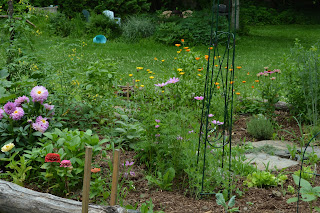Now that the harvest is over and Thanksgiving has come and gone, I want to report on the results of my “keyhole” garden experiment. The idea for this project came from the book, Gaia’s Garden: A Guide to Home-Scale Permaculture by Toby Hemenway. We’re interested in applying permaculture concepts to our land and gardens and we’ve already started to implement some of the practices over the past year, such as chop-and-drop mulching, rainwater conservation, and beginning to plan for layers, guilds, and zones. It will be a multi-year process, like all gardening endeavors! This Spring, I had a brand new garden bed and I was excited to try out the concept of a keyhole garden.
What’s a Keyhole Garden?
| Image credit: http://southwoodsforestgardens.blogspot.com/ |
Often in a conventional garden, plants are in rows, alternating with walking paths; with a keyhole design, gardeners can access plants from the central notch or path and also from the outside of the garden bed. Fewer paths also means more growing area and soil that is less compacted, which is particularly important in permaculture because it emphasizes a no-dig method of gardening.
A keyhole garden may be watered with just one sprinkler placed in the center of the bed. The shape of a keyhole garden can also be used to “catch” sun. With the path or notch oriented toward the South, the “U” shape of the bed captures and holds sunlight. This effect can be enhanced by planting taller vegetables in the back of the bed, trapping light and sun in the garden and also providing a windbreak.
My Own Keyhole Garden Design
Although my new garden bed is square, it was the right size for making use of the keyhole principal. In keeping with the no-dig method, we prepared the bed a few weeks in advance by laying cardboard sheets over the soil to block sunlight, killing the grass and weeds. Tarps went on top of the cardboard, held down with rocks. Early in May, we removed the tarps and broke up the cardboard into smaller pieces for composting in the soil. My brother-in-law provided us with a truckload of excellent composted manure so which gave us a few inches rich, moist soil from the start. |
| My keyhole garden in the morning sun. |
 |
| Side view of the garden in July |
I found that the keyhole design, allowing me access plants
from outside and from the center, made it easier for me to stay on top of
dead-heading, harvesting and pest patrol.
Almost everything I planted was a success (except for a wormy
cabbage that had to be pulled) but it also brought me so much joy. I harvested many wonderful salads and used
herbs in new ways, both culinary and medicinal.
I’ve never grown calendula before but I fell in love with that plant. I put calendula flowers in my salads and harvested
some to dry, but most of all, I simply enjoyed looking at its cheery golden glow
in the garden every single day.
Keyhole Gardens in Arid Regions
Keyhole Gardens in Arid Regions
 |
| My delicata squash plants, beginning to spill over the edge. |















.jpg)





